An overview of standards and guidelines for high-voltage applications.
PCB line spacing is relevant to both safety and function when it comes to traces. Comprised of copper, fuses and insulation, a trace is a conductive connection between different components on a PCB. Numerous factors determine the effectiveness of tracing, including PCB trace widths.
By connecting various signals, the trace is an important connection with its own benefits and avoidable drawbacks.
Traces permit signals to travel between different components. They are necessary but prone to issues, as they are susceptible to potential errors that could lead to a malfunction.
But for products or circuit boards using high voltages, safety standards are extremely relevant. As line spacing between different conductive components increases, so do spacing standards. If the breakdown voltage is exceeded when safety standards aren’t adhered to, arcing could occur along the board, presenting issues between the traces.
Clearance and Creepage
Clearance and creepage are now more than important safety practices; they’re internationally required safety standards. Ultimately, both creepage and clearance are used to prevent arcing. Adhering to those standards is essential for safety and functionality in high-voltage circuitry; otherwise, the PCB and its product may face experience issues.
Creepage considerations are important in all applications and voltages. PCB designers often overlook the need for creepage at lower DC-based voltages, which can sometimes get them in trouble. It’s especially important around connectors and exposed pads placed too close together.
Clearance: A bird’s eye distance between conductive parts. The shortest distance in the air between conductive parts is known as clearance (Figure 1). Clearance can be evaluated by measuring the shortest path that doesn’t pass through insulation, parts or sleeving. Environmental effects are extremely relevant to clearance; humidity can increase the chance of arcing, and moisture and humidity could lead to arc flashes. Dust or other small particles can also cause issues between conductive components.
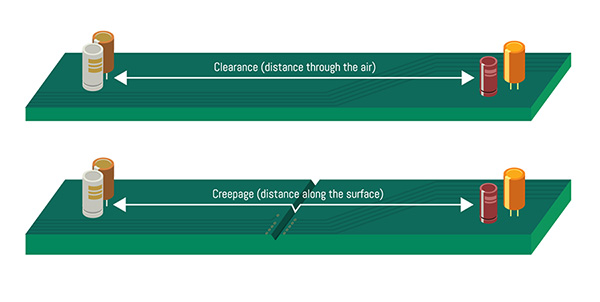
Figure 1. A comparison of clearance and creepage.
Creepage: The surface distance between conductive parts. Creepage is the shortest distance between conductive parts, except they must be along an insulated surface. They also have similar requirements and concerns, with the difference being the insulation of the creepage instead of the air that clearance passes through.
The only difference in these is regarding the surface along which current travels. Creepage goes through an insulated surface, and clearance passes through air. When factoring in the individual specifications, clearance and creepage distance are typically very similar. The only instance where there would be a difference concerns high-voltage circuits that may require different clearances and components.
Several safety regulations pertain to creepage and clearance. They provide direction on operating equipment under ideal conditions and temperatures, and detail how to manufacture industry-acceptable equipment and parts in a safe environment. They include:
- IPC-2221, Generic Standard on Printed Board Design. IPC-2221 details numerous requirements designed to prevent overheating and thermal management issues (Table 1). They ensure a proper trace width is calculated to keep the relevant temperature below its threshold. This is a widely accepted standard that not only lays out best practices, but also establishes material specifications.
Table 1. Electrical Conductor Spacing
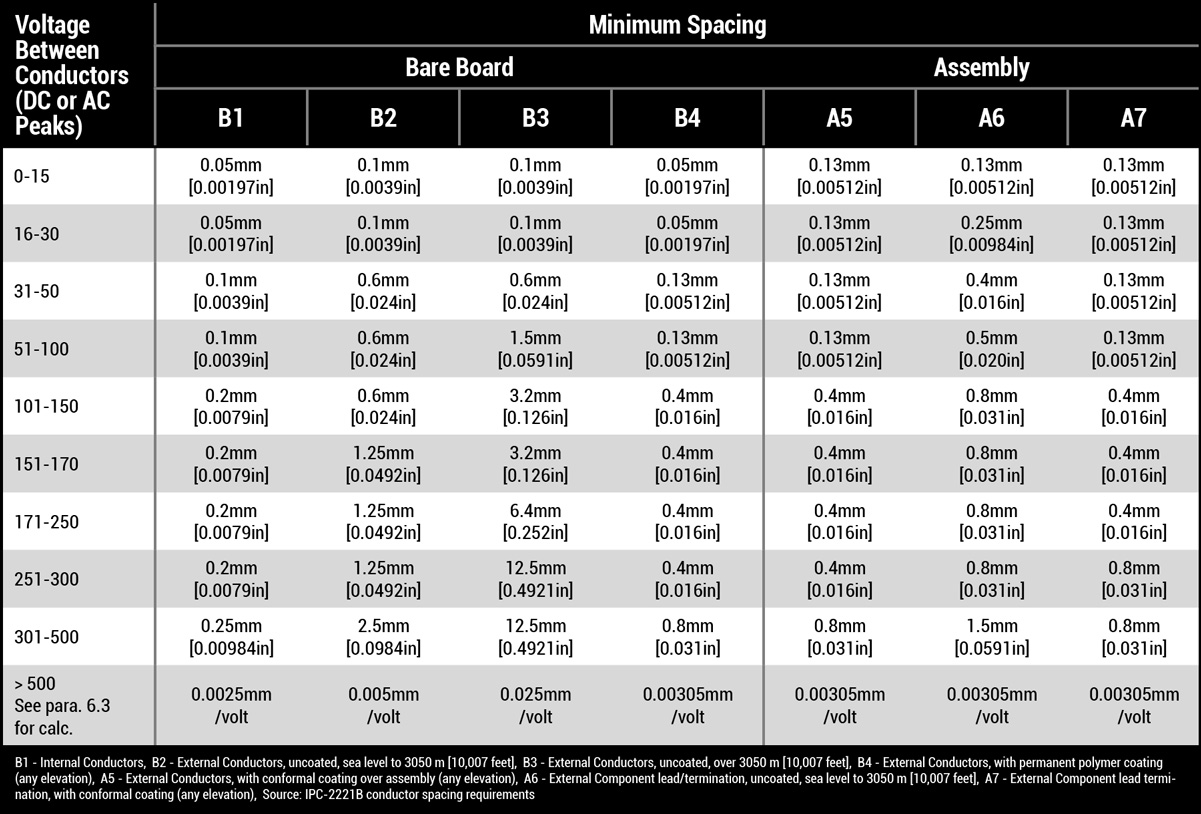
- IPC-2152, Standard for Determining Current Carrying Capacity in Printed Board Design. IPC-2152 provides guidance on determining the appropriate conductor sizes on the finished printed circuit board as a function of the current carrying capacity required and the acceptable conductor temperature rise.
- IPC-9592, Requirements for Power Conversion Devices for the Computer and Telecommunications Industries. This dictates the safety standards specifically for power conversion devices. By establishing a standard power for computers and other communication devices, this creates a safety net by which engineers can analyze spacing requirements based on voltage and whether it’s an external or internal layer.
- UL 61010-1, Standard for Safety Requirements for Electrical Equipment for Measurement, Control, and Laboratory Use; Part 1: General Requirements. This safety standard regards the appropriate distances for clearance and creepage for laboratory and industrial equipment. Poorly measured distances pose a massive risk for equipment used for measuring and controlling processes like pH controllers or temperature. Suggested measurements are laid out in BS EN 61010-1:2010 (“Safety Requirements for Electrical Equipment for Measurement, Control, and Laboratory Use – General Requirements”), including those found in Table 2.
Table 2. Clearances and Creepage Distances for Mains Circuits of Overvoltage Category II up to 300V
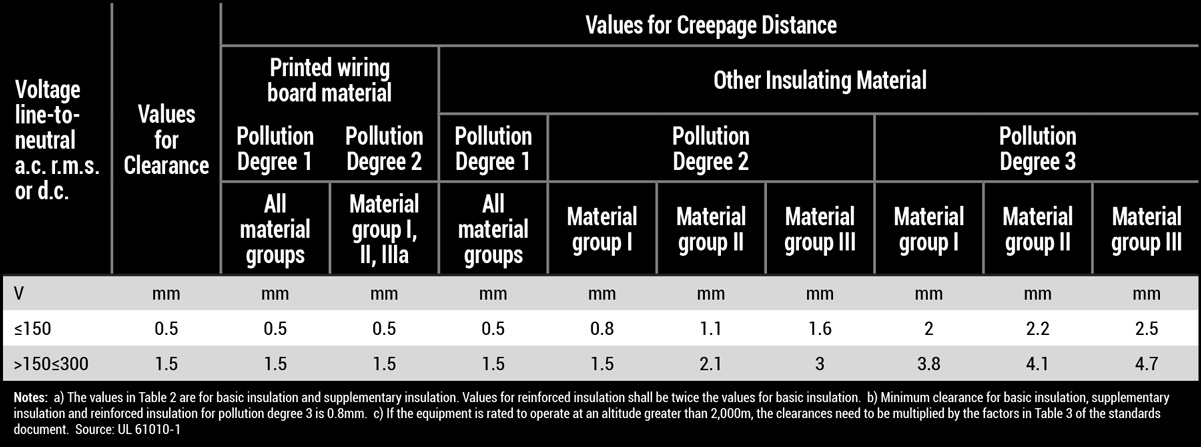
Maintaining these standards isn’t just important; it leads to increased functionality and longer use for the components and the PCB itself. However, this doesn’t address or solve every potential issue with creepage or clearance.
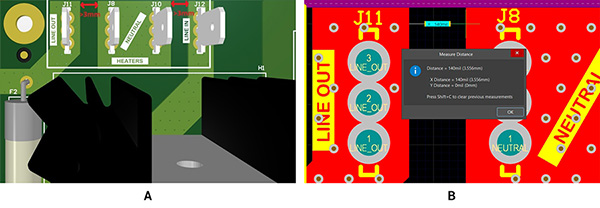
Figure 2. A design with 240VAC input power and >3mm creepage spacing.
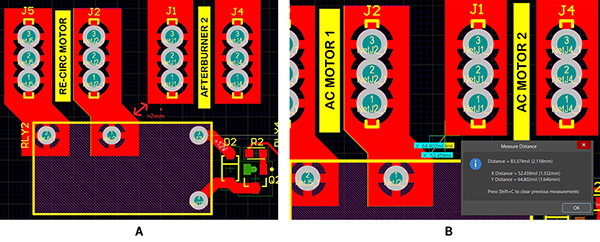
Figure 3. A design with multiple 120VAC motors separated by >2mm creepage spacing.
Calculating the necessary clearance and creepage is just the first step in a complicated process. Temperature, air pollution, moisture, humidity and voltage are all variables that affect the PCB. Guidelines to help avoid concerns and issues when determining creepage and clearance specifics include:
- Constantly monitor spacing between any traces and other components.
- Maintain the “3W principle,” where the spacing between lines must be no less than three times the width of the line itself.
- Determine where high voltage will occur and use larger spaces and distances to prevent issues like arcing.
- Use insulation when necessary, especially when there is a connection between high- and low-voltage components.
- Use curves, not angles, to utilize the shortest possible trace lengths.
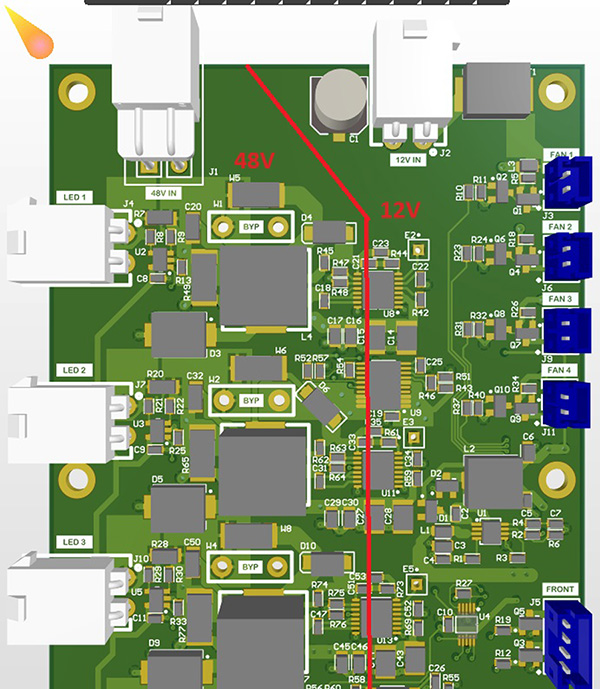
Figure 4. A top-down view of a design containing 48VDC. Creepage should apply to every design, even lower voltages such as 48VDC.
Optimal Materials and Circuits
More demands will be required of the materials and components for high-voltage PCBs and connections. They’ll be more susceptible to voltage fluctuations, exposure to different environments and humidities, and potential overvoltage as the product degrades That’s why it’s incredibly important to use circuits specifically recommended and designed for clearance and creepage (Figure 5).
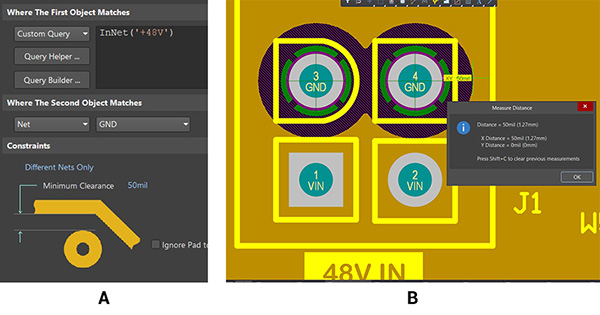
Figure 5. Design rules are set up (left) with the result (right) shown on traces, planes and polygon pours; found on same 48V input power connector (50 mils or >1mm between 48V and ground).
High voltage. High-voltage circuits operating at a minimum of 50V will need longer distances for both clearance and creepage to prevent electrical issues and breakdowns.
Medical devices. Medical devices often have more fail-safes than other industrial equipment. Because of the devices’ importance and significance, both kinds of distances need to be strictly adhered to and specified. Components, use and interaction with patients are all factors for clearance and creepage in medical equipment.
Industrial equipment. OSHA and other governing bodies have put strict specifications on industrial equipment and devices, especially those that account for particulates like dust, heat and vibration/movement.
Power electronics. The higher the voltage and power of a device, the higher the risk of problems. When dealing with high currents and voltage, longer clearance and creepage distances are typically required to avoid issues with arcing, insulation and voltage faults.
Every component needs to be carefully selected for materials. High operating voltages will be a factor, so not only does there need to be accurate spacing, but 2oz minimum traces or vias of copper and resin and glass levels can provide the durability and reliability required for those high-voltage projects and products.
PCB Practices and Standards
Standards and practices are becoming unique to the job or project they’re used for, and that’s expected to continue as technology evolves. Maintain these practices and utilize these materials, and you’re one step closer to stable, high-voltage PCBs.
Andrew Gonzales is vice president of engineering at San Francisco Circuits (sfcircuits.com); This email address is being protected from spambots. You need JavaScript enabled to view it..




















